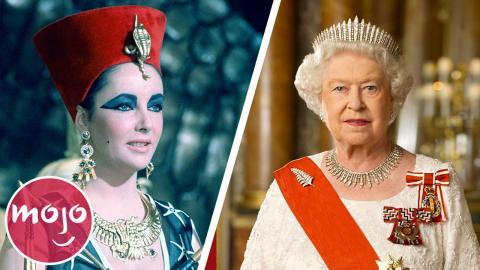Top 20 Most Powerful Women in History

#20: Yaa Asantewaa
Top 10 Most Scandalous Historical Women You've Never Heard Of
This west African warrior fought back against the British and won. Born in 1840, Asantewaa became a ruler within the Ashanti Empire. By 1900, after decades of fighting, the British had claimed the Ashanti’s land for themselves. But administrator Frederick Hodgson made a crucial mistake. He demanded that the Ashanti hand over their Golden Stool – the divine throne that they believe houses the spirit of their people. The Ashanti chiefs were outraged at Hodgson’s audacity, but none more so than Asantewaa. She delivered a powerful speech to the male chiefs, rallying them to renew the fight against their colonizers. In the battles that followed, she commanded 20,000 warriors. Although the British maintained their political control, they never managed to capture the Golden Stool.
#19: Theodora
In the early sixth century, she rose from poverty to become Empress of the Byzantine Empire. After working in a brothel and as an actress, Theodora eventually moved to Constantinople. There she met the Emperor’s nephew, Justinian, who was completely smitten with her. Justinian would eventually become emperor, and Theodora wielded serious influence over her husband, who even called her his partner. During her reign, she expanded women’s rights, making it easier for a woman to get a divorce, own property, and claim custody of her children. She instituted capital punishment for sexual assault, and even rescued young girls from human trafficking. Although she died at only 48 years old, she went down in history as one of the O.G. feminists.
#18: Agrippina the Younger
As a matriarch in early Rome’s most powerful dynasty, she stopped at nothing to gain power and influence for herself and her son Nero. After outliving two husbands – one of whom she might have poisoned – Agrippina married Emperor Claudius, who also happened to be her uncle. Even back then, the marriage was considered scandalous, but it allowed Agrippina to position her son in line for the throne. Ancient historians report that as Empress, she bent Claudius to her will, convincing him to adopt Nero and promote him over his own son. She took on duties that were usually exclusive to men, including meeting with foreign officials and approving government documents. Her level of authority was almost unheard of for a woman at the time.
#17: Elizabeth II
The Untold Story of Queen Elizabeth II
When her father, King George VI, died, Princess Elizabeth became queen at just 25 years old. As the ruler of one of the most powerful monarchies in the world, she was the head of state for 32 independent nations during her tenure. And her 70-year reign was the longest of any woman in history, and the second longest of any monarch, ever. During her seven decades as queen, she presided over multiple major global events, including the decolonization of many of the UK’s territories. Although the British monarch doesn’t usually intervene directly in political affairs, Elizabeth’s influence as an unofficial ambassador and a patron of hundreds of charities was significant.
#16: Eleanor of Aquitaine
During the Middle Ages, she was queen of not one, but two major European nations. She accompanied her first husband, King Louis VII of France, on the Crusades in the 1140s, where she gained a reputation as a wise and strong leader. After her marriage to Louis was annulled, Eleanor would have been happy to stay single, but that wasn’t an option for a woman with her money and influence. Instead, she married Henry, who became King Henry II of England just two years later, embarking on a long, and complicated relationship. When her son Richard I ascended to the throne, Eleanor’s power increased even more. She had considerable control over the country while Richard was away in the Crusades and when her youngest son, John, succeeded his brother as king.
#15: Golda Meir
Born in Kyiv in 1898, she grew up amidst poverty and anti-Jewish persecution. In the 1920s, Meir moved to a Jewish commune in Palestine, where she began climbing the political ladder. She was a vital player in the creation of Israel, and over the years, served as ambassador, legislator, and foreign minister. In 1969, she became the country’s first female prime minister. When a surprise attack from Syria and Egypt in 1973 led to the Yom Kippur War, Meir’s aggressive leadership earned her the nickname “Iron Lady” more than two years before Margaret Thatcher claimed it. However, many Israelis blamed her for the heavy loss of life, and she resigned the following year.
#14: Nzinga of Ndongo & Matamba
Remembered today as the Mother of Angola, this queen is still honored in her native country as a brilliant politician, military tactician, and diplomat. When Nzinga became ruler of Ndongo in 1624, the land was facing attacks from both Portuguese slave traders and rival African nations. To protect her people, she allied with Portugal, but just two years later, the Portuguese broke their treaty, forcing Nzinga and her people to migrate west. There, they founded the new nation of Matamba, where Nzinga offered protection to runaway slaves and built a powerful militia. Although they were unable to reclaim Ndongo from the Portuguese, Nzinga positioned Matamba as an important center of trade, until its economy was strong enough to do business with Portugal as equals.
#13: Amanirenas
The Kingdom of Kush was wealthy and prosperous. That’s probably why the Roman Empire was eager to invade it. But Queen Amanirenas didn’t give in easily. Described as being blind in one eye, she led an army of 30,000 men against the invaders. Although the Kushites were defeated, Amanirenas’ forces put up such a fight that Caesar Augustus granted her demand for a peace treaty, stopping the Roman expansion into Africa. We still don’t know whether he forgave her for decapitating his statues. Kush was known for its powerful female leaders. Queen Shanakdakhete followed in Amanirenas’ footsteps, and was even referred to as the “Son of Ra” and “Lord of the Two Lands.” She now lies in one of the region’s most impressive pyramids.
#12: Isabella I of Castile
Not everyone on our list used their power for good. Isabella was queen of Castile and eón. In 1469, her marriage to King Ferdinand II of Aragon united Spain into one kingdom. Together, they started the Spanish Inquisition, targeting Muslims and Jews who were accused of being heretics. Under Isabella’s rule, hundreds of thousands of Jews were forced to convert to Catholicism, and tens of thousands were expelled from the country. She was known for cracking down on crime and expanding the power of the monarchy. Isabella also bankrolled Christopher Columbus’s first voyage west. To her credit, when he came back with a ship full of enslaved people, she ordered him to take them back home, and decreed that Indigenous Americans be treated with fairness.
#11: Indira Gandhi
No, she’s not related to that Gandhi – it’s just a common name. Elected India’s first female prime minister in 1966, she quickly became popular for modernizing the country’s agricultural systems and fighting poverty. However, she soon devolved into an authoritarian. When Gandhi was convicted of corruption in 1975, she could have left office gracefully. Instead, she declared a state of emergency that came to be known as the “Reign of Terror.” She imprisoned her rivals, suspended civil liberties, and censored the press. During this time, she also rounded up and sterilized millions of poor men in the name of population control. Amazingly, Gandhi was still reelected in 1980, but in 1984 she was assassinated by two of her own bodyguards.
#10: Lady K'abel
Lady Lynn Forester de Rothschild: Interview with the Financier and Thought Leader
The Maya people called her by many names: Lady Snake Lord, Lady Water Lily Hand, and most importantly, Kaloomte, or Supreme Warrior. Part of a powerful family, K’abel ruled the Wak’a kingdom in the Maya empire from 672 to 692 AD. She married a lower ranking man, though whether this was for love or to maintain her status as the highest ruler, we don’t know. Her famous stone sculpture portrays her in an elaborate royal wardrobe and being attended by a slave. Although female rulers weren’t common among the Maya, they weren’t unheard of either. In fact, during the seven centuries of the Mayan Classical era, multiple city-states were ruled by queens like Lady K’abel.
#9: Tamar of Georgia
King George III played an influential role in his country’s rise to prominence, but he had a predicament. Though Georgia had never had a female rule, he named his daughter Tamar as his successor. To make sure she held onto her claim to the throne, he crowned her his co-ruler in 1178, when she was a teenager. After his death, she took the title of “king” and ruled Georgia for twenty-four years. Tamar commanded a formidable army that enabled her to expand her territory. Her reign is recognized as Georgia’s Golden Age. She was revered in her own time, and was even the subject of epic poetry. She was later canonized by the Georgian Orthodox Church, and is still considered a hero in her country.
#8: Empress Dowager Cixi
Although she started her royal tenure as a concubine, Cixi rose to become one of the most powerful people in the Qing dynasty. When the Xianfeng Emperor died in 1861, Cixi’s son took his place at just five years old. Cixi lost no time in removing the eight regents appointed to rule until the young monarch came of age, though to be merciful, she only had three of them executed. When her son passed away at just eighteen, she promoted her four-year-old nephew to the throne and continued to rule as regent. Even when the boy reached adulthood, many top officials were more loyal to Cixi than to the actual emperor. She remained a powerful influence over the empire until her death in 1908.
#7: Margaret Thatcher
Perhaps the most controversial figure on our list, she became Britain’s first female prime minister in 1979. During her eleven years in office, she instituted sweeping economic changes that came to be known as Thatcherism. This involved massive privatization of state industries, financial deregulation, consolidating power in the central government, and undermining unions. Although unemployment spiked during her first term, she was reelected in a landslide – twice. Though she was widely admired, she was also widely hated, as poverty and income inequality soared during her tenure. In her third term, she passed an extremely unpopular flat tax and became increasingly skeptical of the European Union. These two factors tanked her support within the Conservative party, and she resigned in 1990, leaving behind a complicated legacy.
#6: Zenobia
The Palmyrene Kingdom was a state within the Roman Empire located in present-day Syria. But Queen Zenobia wasn’t content to remain a Roman subject. After her husband was assassinated in 267 AD, Zenobia’s young son became king, and she ruled as regent in his place. She rebelled against the Romans, declaring her land to be its own empire, and even expanded her territory by invading Egypt. Zenobia was a well-educated intellectual who spoke Aramaic, Greek, Latin, and Egyptian. She ruled over a vibrant, multicultural nation famous for its diversity and religious tolerance. Sadly, it was short-lived, as the Romans took back the territory in 272 and captured Zenobia. Her fate remains unknown, but her reputation as a bold and brilliant leader lives on.
#5: Maria Theresa
During her reign from 1740 to 1780, she instituted sweeping reforms that ushered the Hapsburg Empire into the Enlightenment. However, in Maria Theresa’s case, perhaps the ends didn’t always justify the means. She created public schools to increase literacy among the poor, but she arrested anyone who opposed her, including peasants who needed their kids to work the fields. She supported the new science of vaccines, but had the shots tested on orphans before taking them herself. Her overhaul of the feudal system ensured that serfs could support their families. But she also passed strict morality laws and authorized a secret service to spy on people suspected of impropriety. Ultimately, Maria Theresa was a complicated but hugely significant figure in European history.
#4: Wu Zetian
Top 10 Woman Spies In History
Smart, ruthless, and ambitious, she maintained authority by eliminating anyone who might oppose her. Like Empress Dowager Cixi, she entered the royal court as a concubine. When she married the emperor in 655, she became the Empress Consort. After her youngest son took the throne, she forced him to step down so she could reign alone. Wu Zetian had her secret police spy on her adversaries, planted false accusations of witchcraft, and exiled or executed those who spoke against her. Under her leadership, China expanded its territory by invading its neighbors, and its culture and economy thrived. It’s fair to say that while those closest to her suffered, the rest of her empire flourished.
#3: Cleopatra
Modern portrayals tend to fixate on her beauty and relationships to the men around her. But the last pharaoh of the Ptolemaic Kingdom of Egypt was a well-educated, savvy politician and diplomat who spoke nine languages and constantly had to negotiate tensions with Rome. When her father died around 50 BC, Cleopatra and her brother Ptolemy XIII jointly inherited his throne. However, the two became rivals, with most Egyptian officials siding with Cleopatra. After Ptolemy XIII died in battle against Julius Caesar, his sister promoted her son as her co-ruler. Her years-long relationship with Mark Antony allowed her to expand Egypt’s power and territory. However, it ended in tragedy when the pair were defeated by Octavian, and Cleopatra’s kingdom was absorbed into the Roman Empire.
#2: Hatshepsut
Fifteen hundred years before Cleopatra, another woman ruled ancient Egypt. When Hatshepsut’s husband, Pharaoh Thutmose II, died, she became queen regent for her two-year-old stepson. Just seven years later, she declared herself pharaoh – an unheard-of move in the male-dominated society. To project authority, she had herself portrayed with a traditional false beard and masculine clothes. Her 22-year reign was a time of prosperity and political stability. Hatshepsut re-established trade routes, had hundreds of new monuments and buildings constructed, and promoted the arts. After her death in 1458 BC, her stepson attempted to erase her legacy, destroying artwork of her, erasing her name from historical documents, and stealing credit for her achievements. Despite his efforts, Hatshepsut is still remembered as one of Egypt’s greatest rulers.
#1: Catherine the Great
Born to a noble but poor German family, Catherine’s mother was determined to marry her to someone powerful. She was invited to visit Russian Empress Elizabeth, who was so impressed by the smart young girl, that she betrothed Catherine to Peter, her nephew and heir. Catherine agreed to the marriage despite her contempt for Peter’s ignorance and drinking. Just six months after he inherited the throne, Catherine staged a coup, had Peter arrested, and declared herself ruler. As Empress, she expanded Russia’s territory and promoted science and the arts. She was particularly concerned with public health, establishing hospitals and promoting vaccination. Both her romantic and her political exploits are now the stuff of legend. Which powerful woman inspires you the most? Be sure to let us know in the comments below.





